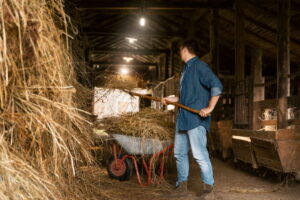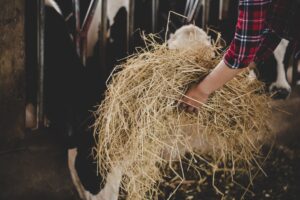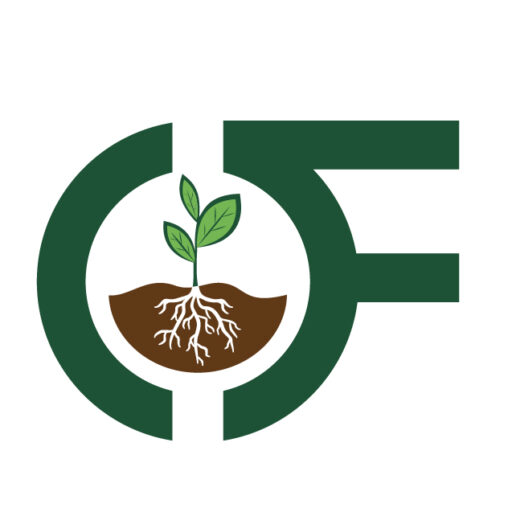Frequently Asked Questions about Hay
A hay bale is a compact, bound bundle of hay, which is grass or other plant material that has been cut, dried, and stored for use as animal fodder, particularly for grazing animals like cattle, horses, goats, and sheep. Hay bales are created using a machine called a baler, which compresses the hay into a dense, manageable form and ties it with twine, netting, or wire to keep it together.
The cost of a bale of hay can vary widely based on several factors including the type of hay (like Alfalfa, Orchard, Timothy, or a mix), the quality of the hay, the size of the bale, regional market conditions, and the time of year.
The weight of a bale of hay can vary significantly depending on the type of hay, its moisture content, and how tightly it’s baled. Generally, there are two common types of hay bales: small square bales and large round or square bales.
- Small Square Bales: These typically weigh between 80 to 100 pounds . They are easier to handle and are commonly used for feeding smaller herds or individual animals.
- Large Round Bales: These can weigh anywhere from 500 to 1,500 pounds. They are more efficient for feeding larger herds and require machinery to move.
- Large Square Bales: Similar to round bales, these can vary in weight but are often in the range of 1000 to 2,000 pounds.
It’s important to note that these are general estimates, and actual weights can differ based on factors like the baling equipment used, the type of crop being baled (such as alfalfa, timothy, or a mix), and the conditions at the time of baling.
Ohana Hay is proud to offer high-quality hay across all of Washington State and the surrounding states, ensuring that no matter where you are in the region, your animals receive the best in nutrition and care. Our commitment to excellence extends beyond state lines, bringing top-grade Alfalfa, Orchard, Timothy, and mixed hay varieties to a broader community of animal caretakers.
The number of hay bales you can produce per acre depends on various factors, including the type of hay, the quality of the soil, weather conditions, and the farming practices employed. However, some general estimates can be provided:
For Small Square Bales: Farmers often report yields of anywhere from 50 to 150 small square bales per acre. This range can vary depending on the density and size of the bales, as well as the factors mentioned above.
For Large Round Bales: The number is significantly less due to the size of these bales. On average, you might expect around 4 to 6 large round bales per acre, but again, this can vary.
For Large Square Bales: Similar to large round bales, the number per acre will be lower than small square bales. The average might be around 6 to 10 bales per acre, depending on the size of the bales and other conditions.
The type of hay being grown also influences yield. Alfalfa, for example, typically has a higher yield per acre compared to grass hays like Timothy or Orchard grass, assuming optimal growing conditions.
The number of hay bales needed to feed a cow through the winter depends on several factors, including the cow’s size, age, and whether she is pregnant or lactating, as well as the quality of the hay and the length of the winter. However, a general estimate can be provided for planning purposes.
A mature cow typically consumes between 2% to 2.5% of her body weight in dry matter each day. Assuming an average weight of about 1,200 pounds (545 kg) for a mature cow, she would need about 24 to 30 pounds (11 to 13.5 kg) of hay per day.
Considering the weight of hay bales:
Small Square Bales: These typically weigh around 80 to 100 lbs each. So, a single small square bale could feed a cow for about 3-4 days.
Large Round Bales: If these weigh around 500 to 1,500 pounds pounds each, one large round bale could potentially feed a cow for approximately 33 to 42 days, depending on her specific needs and the bale weight.
Large Square Bales: These typically weigh around 1000-2000 lbs each. So a single square bale could feed a single cow for as much as 80 days.
For an entire winter period, which can be roughly considered as 120 to 180 days, depending on the location:
For small square bales (assuming 80-100 pounds each): A cow might need around 60 to 90 bales.
For large round bales: A cow might need about 3 to 5 bales.
For large square bales: A cow might need as much as 2-3 bales to get through the winter.
Remember, these are rough estimates. Actual needs can vary based on the specific conditions of the winter, the cow’s health and nutritional requirements, and the quality and type of hay being fed (like Alfalfa, Orchard, Timothy, or mixes). It’s always best to consult with a local agricultural extension office or a livestock nutritionist for more tailored advice. Additionally, having extra hay on hand is wise in case of an unexpectedly long or harsh winter.
Yes, using hay bales as seating for a wedding is a popular and charming idea, especially for outdoor, rustic, country, or barn-themed weddings. Here are some points to consider if you’re thinking about using hay bales for wedding seating:
- Comfort: Hay bales can be hard and scratchy, so it’s a good idea to cover them with blankets, quilts, or fabric to provide more comfort for guests. This also adds a decorative touch to match your wedding theme.
- Stability: Ensure that the hay bales are placed on a flat surface to prevent them from tipping over. It’s important to consider the safety and stability of the seating.
- Allergies: Be aware that some guests might have allergies to hay, so it’s considerate to have alternative seating options available for them.
- Weather Protection: If your wedding is outdoors, have a plan for protecting the hay bales in case of rain, as wet hay can become soggy and unusable. A tent or a similar covering can be a good solution.
- Quantity and Arrangement: Plan the number of hay bales needed based on your guest list, and arrange them thoughtfully for optimal viewing and comfort. Remember, one standard square bale typically seats two people.
- Decoration: Hay bales offer a great opportunity for decoration. You can adorn them with flowers, ribbons, or other elements that fit your wedding’s theme.
After-Event Use: Consider what you will do with the hay bales after the wedding. They can be donated to a local farm, used for gardening, or repurposed in other ways.
To determine how many bales are in a ton of hay, you need to know the average weight of the bales you’re using. The number of bales per ton will vary depending on whether you’re dealing with small square bales, large round bales, or large square bales, as they each have different typical weights. Here’s a general guideline:
- Small Square Bales: If we assume an average weight of around 80-100 pounds per bale, there are 2,000 pounds in a ton, so you would have 20 small square bales in a ton (2,000 pounds / 100 pounds per bale = 20 bales).
- Large Round Bales: If a large round bale weighs approximately 1,000 pounds, then there would be 2 bales in a ton (2,000 pounds / 1,000 pounds per bale = 2 bales).
- Large Square Bales: If a large square bale weighs around 1000-2000 pounds, then there would be about 1-2 bales in a ton (2,000 pounds / 1000 pounds per bale = 2 bales).
These are approximations, as the actual weight of hay bales can vary based on factors like the type of hay, the density of the bale, and the moisture content at the time of baling. It’s always a good idea to have an accurate weight for your specific bales to make precise calculations.
The number of bales of hay a horse will need depends on several factors, including the horse’s size, activity level, the quality of the hay, and whether the hay is the primary source of forage. However, a general guideline can be provided.
A horse typically eats about 1.5% to 2.5% of its body weight in forage per day. For an average-sized horse (about 1,000 pounds), this translates to 15 to 25 pounds of hay daily.
Using small square bales as an example, which commonly weigh between 80 to 100 pounds:
- If a horse eats 20 pounds of hay per day, and the bale weighs 80-100 pounds, then each bale would last for about 5 days.
For large round bales, which can weigh between 500 to 1,500 pounds, the calculation will be different. If you use a 1,000-pound bale:
- A 1,000-pound bale would last a single horse around 50 days (1,000 pounds / 20 pounds per day = 50 days), assuming the horse has no other sources of forage.
These are approximate figures, and actual needs can vary. The horse’s access to pasture, the type of hay (like Alfalfa, Orchard, Timothy, or mixed), and the horse’s overall diet should also be taken into account. It’s best to consult with a veterinarian or an equine nutritionist for more precise feeding recommendations tailored to your horse’s specific needs.
Hay bales have several uses, both in agricultural settings and beyond. Here are some of the primary uses:
- Animal Feed: The most common use of hay bales is for feeding livestock, including cattle, horses, sheep, goats, and rabbits. Hay provides essential nutrients, especially during times when pasture grass is not available, such as in winter.
- Bedding for Animals: Hay can also be used as bedding material for animals. While straw is more commonly used for this purpose due to its lower cost and better absorption, hay can also be used, especially if straw is not available.
- Gardening and Landscaping: Hay bales can be used in gardening for mulching to suppress weeds, retain soil moisture, and add organic matter to the soil as they decompose. They are also used in straw bale gardening, where the bales themselves become the medium for growing plants.
- Erosion Control: Large hay bales can be strategically placed to prevent soil erosion, especially on construction sites or in areas with disturbed soil.
- Building Material: In some cases, hay bales are used as an eco-friendly building material for constructing walls in houses. They provide excellent insulation and are a renewable resource.
- Seating and Decor: Hay bales are popular for rustic-themed events, like outdoor weddings or festivals, where they are used as seating or decorative elements.
- Feed for Composting: Hay can be used as an ingredient in compost piles. It’s a good source of carbon, which helps balance the nitrogen in kitchen scraps and green waste.
- Fodder for Animals in Training or Shows: Hay bales can be used in training horses or for show purposes, such as in jumping courses in equestrian events.
Art and Festive Displays: In some communities, hay bales are creatively used in art installations or festive displays, especially during fall or harvest-themed events.
The use of hay bales varies based on the specific needs of the users, reflecting their versatility in both agricultural and non-agricultural contexts.
A hay baler is a piece of farm machinery used to compress cut and raked hay into compact bales for easy handling, transport, and storage. Here’s a basic outline of how a hay baler works:
- Picking Up the Hay: The baler is pulled behind a tractor and has a pickup mechanism, which is a series of rotating bars with teeth or tines. These teeth scoop up the hay from the windrows (rows of cut hay left to dry in the field) and feed it into the machine.
- Compacting the Hay: Inside the baler, the hay is compacted into the desired shape by a plunger (in square balers) or by rotating elements (in round balers). For square balers, the plunger compresses the hay against a bale chamber, forming a tightly packed, rectangular shape. For round balers, the hay is rolled into a cylindrical shape.
- Tying the Bale: Once the hay is compacted to the right density and size, it needs to be tied to hold its shape. In square balers, twine or wire is automatically wrapped around the bale by the baler’s knotters. In round balers, netting or twine is wrapped around the bale to secure it.
- Ejecting the Bale: After the bale is formed and tied, it is ejected from the baler. Square balers drop the bales onto the field, while round balers have a rear gate that opens to release the bale.
- Balers with Advanced Features: Some modern balers come with advanced features like moisture sensors to ensure the hay is at the correct moisture level for baling, and computerized systems that can control the density and size of the bales.
The design and operation of the baler depend on whether it’s a round baler or a square baler. Round balers are generally used for producing larger bales that are more suited for feeding larger herds of livestock, while square balers produce smaller, more manageable bales that are often preferred for smaller operations or for feeding horses.
Hay bales are often left in fields for several reasons:
- Temporary Storage: After baling, hay bales may be left in the field temporarily until they can be transported to a storage area. This is often due to logistical reasons like availability of labor, transport means, or suitable storage space.
- Field Drying: Sometimes, bales are left in the field to further dry out, especially if they were baled with a slightly higher than ideal moisture content. Leaving them in the sun can help reduce the moisture level, which is crucial to prevent mold growth and spoilage.
- Strategic Feeding: In some cases, especially with large round bales, they are left in the field intentionally for grazing animals to feed on directly. This is a common practice in extensive grazing systems where livestock are allowed to feed on the bales as needed.
- Weather Conditions: If the weather turns bad quickly, farmers might not have enough time to move the bales before rain or snow. In such cases, the bales are left in the field until the weather clears up.
- Rotational Grazing Practices: Farmers practicing rotational grazing might leave bales in specific fields to be used at a later date when livestock are rotated to that particular pasture.
- Land Management: In some instances, bales might be left to decompose in the field as a way to return organic matter and nutrients to the soil, although this practice is less common since it can be inefficient and might attract pests.
- Aesthetic or Recreational Reasons: Occasionally, hay bales are left in fields for aesthetic purposes, especially in areas where the rural landscape is part of the local charm or for recreational activities like hay bale mazes.
It’s important to note that while there are practical reasons for leaving hay bales in fields, prolonged exposure to weather can degrade the quality of the hay, so ideally, they should be moved to a covered storage area as soon as feasible.
Baling hay is a multi-step process that involves several stages: cutting, drying (or curing), raking, and finally baling. Here’s a simplified overview of how hay is baled:
- Cutting the Hay: The first step is to cut the grass or alfalfa with a mower. This is typically done when the plant is at the right stage of growth for optimal nutritional content and before it reaches full bloom.
- Drying the Hay: After cutting, the hay needs to dry or cure in the field. This process involves leaving the cut hay on the ground to dry in the sun. The drying time can vary depending on the weather but usually takes a few days. It’s important that the hay is dry to prevent mold and spoilage.
- Tedding (Optional): If necessary, the hay can be tedded, which means spreading it out with a special machine to speed up the drying process.
- Raking: Once the hay is dry, it’s raked into rows. The rake gathers the hay into neat lines, making it easier for the baler to pick up.
- Baling: The baler is then driven over these rows. Inside the baler, hay is compacted into either round or square shapes and then tied with twine or wire. Small square balers, large round balers, and large square balers are the common types used, depending on the desired size and shape of the hay bales.
- Storing the Bales: After baling, the hay is stored in a dry place to protect it from weather and to maintain its quality. Proper storage is crucial to prevent the hay from getting wet and moldy.
Each step in the process is crucial for ensuring the quality of the hay. The timing of each step, especially cutting and drying, is dependent on weather conditions, as hay needs to be dry to bale and store properly. Modern farming equipment has made each step more efficient, but the basic principles of haymaking remain largely unchanged.
The number of flakes in a bale of hay can vary depending on the size of the bale and how tightly it’s been packed. Typically, a small square bale of hay, which is commonly used for feeding horses, is divided into flakes for ease of handling and feeding.
- Small Square Bales: These bales generally have between 12 to 16 flakes each. The exact number can vary based on the size of the bale and the type of hay baler used.
- Large Round or Square Bales: These bales are not typically divided into flakes and are instead fed using different methods, such as unrolling or using a bale processor for large herds.
The concept of a flake is specific to small square bales. Each flake is essentially a section of the bale that is easily separated due to the way the baler compresses and cuts the hay during the baling process. The size of a flake is important for determining feed portions, especially for horses, as it helps in providing consistent and controlled feed amounts. However, the weight and nutritional content of a flake can vary, so it’s important to consider these factors along with the flake count when planning an animal’s diet.
The amount of hay a goat consumes depends on its size, breed, life stage (such as whether it’s a kid, pregnant, or lactating), and whether the hay is the primary source of its diet or supplemented with pasture, browse, and other feeds. Goats are smaller ruminants and generally have a lower feed intake compared to larger livestock like cows or horses.
On average, a goat might consume between 2% to 4% of its body weight in dry feed per day. Assuming an average adult goat weighs around 135 pounds (61 kg), it would eat about 2.7 to 5.4 pounds (1.2 to 2.4 kg) of hay per day.
Considering small square bales, which typically weigh between 80 to 100 pounds:
- If a bale weighs 100 pounds, it would have enough hay to feed a goat for about 25 days.
The number of bales needed annually can be calculated by considering how many days a year the goat will be fed hay. For example, if hay is the primary feed for six months (about 180 days), you would need roughly 7-8 bales per goat for that period (180 days / 25 days per bale).
These are estimates and actual requirements can vary. Factors like the quality of the hay, the goat’s overall diet, and the availability of other forage sources play significant roles in determining the exact amount of hay needed.





